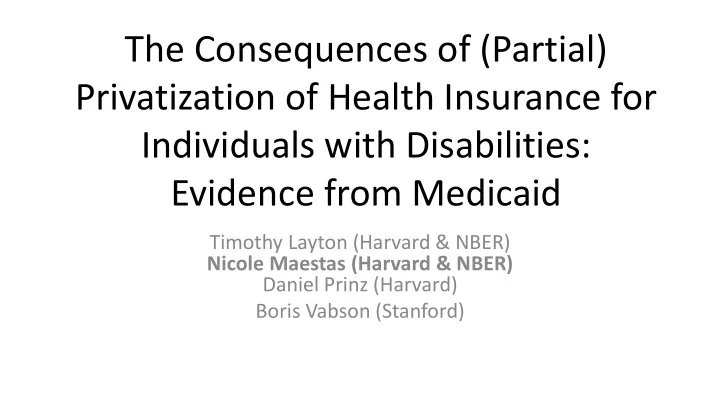

The Consequences of (Partial) Privatization of Health Insurance for Individuals with Disabilities: Evidence from Medicaid Timothy Layton (Harvard & NBER) Nicole Maestas (Harvard & NBER) Daniel Prinz (Harvard) Boris Vabson (Stanford)
Social health insurance programs in the U.S have undergone rapid privatization in recent years
Privatization in Medicaid • Privatization almost complete in terms of enrollment • But just getting started in terms of $$
Privatization in Medicaid • Privatization almost complete in terms of enrollment • But just getting started in terms of $$
This paper: Medicaid managed care among the disabled In this paper, we study the consequences of the (partial) privatization of Medicaid benefits for the disabled (SSI) population Why the disabled? • Disabled (SSI) population are least healthy group of Medicaid enrollees – 13.5% of enrollment, 40% of Medicaid spending • Allows us to get better picture of effects of privatization on healthcare – General Medicaid population (moms and kids) likely affected by privatization but difficult to observe due to low average healthcare use • Also the group for which privatization question is currently most relevant – Portion in private plan increased from 25% in 2006 to over 50% in 2012 • What do we do? – Combine natural experiments (county-level introduction/mandates) in Texas and New York with rich administrative claims and enrollment data – Clean difference-in-differences variation in MMC implementation
1. Background: MMC Program Features
Medicaid Managed Care (MMC) Program Features
Texas MMC Roll-out • Treatment counties in Travis, Harris, Bexar, Nueces services areas • Control counties contiguous to treatment counties • MMC rolled out in February 2007; roll-out was sharp and significant
New York MMC Roll-out • Treatment counties: MMC rolled out AND contiguous to county in same service area without MMC • Control counties: contiguous to treatment counties in same service area • MMC introduced in January 2007; gradually mandated throughout 2009; messy, use to validate TX results
2. Data and Empirical Strategy
Data and Sample • Data: – 2004-2010 Medicaid Analytic eXtract (MAX) from CMS – Beneficiary characteristics and enrollment Information – Comprehensive claims data (inpatient, outpatient, Rx) – Covers everyone in FFS Medicaid and in Medicaid managed care • Sample: – Construct (unbalanced) individual panel – Restrict to individuals: • Enrolled in Medicaid • Disabled • Not in Medicare • Over 21 • Not in MMC prior to February 2007
Population is sick (especially for Medicaid)
Empirical approach • Identification based on timing of exogenous switch from FFS to MMC in “treatment” counties; compare to contiguous control counties • Difference-in-differences • Control for individual fixed effects in most analyses • Control for service area-by-year fixed effects • Event study: 2010 𝑍 𝑗𝑢 = 𝛾 0 + 𝛾 𝑢 𝑈𝑠𝑓𝑏𝑢 𝑗𝑢 + 𝛽 𝑡𝑢 + 𝛿 𝑗 + 𝜁 𝑗𝑢 𝑢=2004 • Incomplete takeup motivates IV: 𝑄𝑠𝑗𝑤𝑏𝑢𝑓 𝑗𝑢 = 𝜀 0 + 𝜀 1 𝑈𝑠𝑓𝑏𝑢 𝑗𝑢 × 𝑄𝑝𝑡𝑢 𝑢 + 𝛽 𝑡𝑢 + 𝛿 𝑗 + η 𝑗𝑢 𝑍 𝑗𝑢 = θ 0 + θ 1 𝑄𝑠𝑗𝑤𝑏𝑢𝑓 𝑗𝑢 + 𝛽 𝑡𝑢 + 𝛿 𝑗 + ψ 𝑗𝑢
3. Results
Healthcare spending rose (Texas) • MMC caused higher realized spending: Almost 20% by 2010 • For services for which we observe both MMC and FFS payments, prices are similar • Suggests spending increase was due to quantity, not prices
Drug utilization increased Log spending Log Days Supply • IV: 27% spending increase; 26% days supply • No overall extensive margin (any drugs) effects; but strong class-specific extensive margin effects • No effect in New York
Log Rx spending by therapeutic type Texas New York
Log Rx spending by therapeutic type Texas New York
Reasons for the increase in Rx use 3 features can potentially explain drug result • Drug cap (TX) • Drug carve-out (TX and NY) • Shift to MMC for medical benefits (TX and NY) Recall: • Large effect of privatization on drug use in TX • No effect in NY
Drug utilization rose most for those constrained by the drug cap Texas New York • Suggests relaxing drug caps are responsible for increase in drug spending • Important to note that drug caps are a feature of many FFS Medicaid programs; not a feature under MMC
Log inpatient spending fell (Texas) • Mostly through extensive margin (reduction in admissions) • All driven by reduction in non-surgery admissions • Even larger decrease in New York
Inpatient drop driven by fewer mental health admissions (both TX, NY) Texas New York • PQI: Also find reductions in admissions related to asthma, but not COPD or CHF
Outpatient utilization rose Outpatient days Log Outpatient Spending • IV: 14% spending increase; 8 day increase (baseline 28); similar in NY • No extensive margin (any outpatient days) • Coding changes make it difficult to decompose
Conclusion • Find that privatization of Medicaid for SSI beneficiaries raised spending, but increases are consistent with quality improvements • No obvious stinting/quality deterioration • Suggests privatization of health insurance for this complex population does not do harm, and may be beneficial – Costs more money, but that money goes to providers/patients (not plans) – Some state FFS plans ration care to SSI beneficiaries to control costs • Features of both the public and private programs matter when considering consequences of privatization consequences may vary by state • Next steps: examine effects on SSI outcomes — employment and mortality
Recommend
More recommend